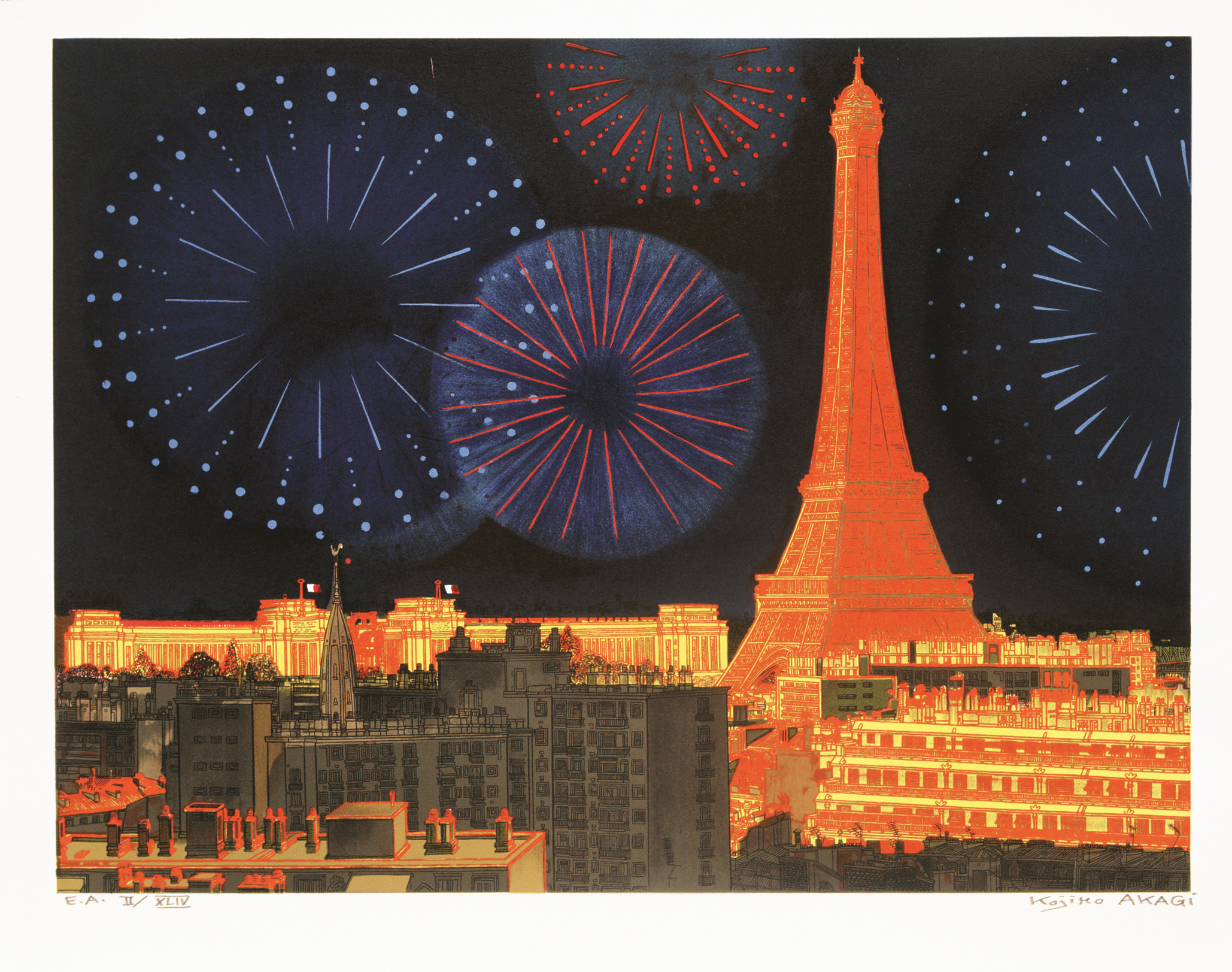Le feu d’artifice du 14 juillet / The fireworks display on July 14 / 七月十四日の花火
Dublin Core
タイトル (Title)
Le feu d’artifice du 14 juillet / The fireworks display on July 14 / 七月十四日の花火
テーマ (Subject)
Feu d'artifice, Lithographie
詳細 (Description)
Le bâtiment en arrière-plan de l’illustration est le Palais de Chaillot situé place du Trocadéro. C’est un pavillon construit pour l’Exposition Universelle de 1937, juste avant l’occupation allemande. De cette terrasse, la vue sur la tour Eiffel et les toits de Paris est exceptionnelle. C’est ici que viennent beaucoup de touristes dès leur arrivée à Paris. Après l’Exposition universelle, le bâtiment est réutilisé. Il abrite aujourd’hui différents musées et, au sous-sol, le Théâtre National de Chaillot. Au Musée de la Marine, la collection des vues des ports de France et les maquettes de bateaux sont incontournables. Au Musée de la Cité de l’Architecture et du Patrimoine, on visite une collection rare de maquettes taille réelle de pièces d’architectures représentatives des monuments célèbres de la France entière, de l’antiquité à nos jours. Au Musée de l’Homme, on voit une maison venant des montagnes de la région de Nagano. Alors qu’elle était dans un état de délabrement, elle a été entièrement démontée puis transportée et reconstruite à l’intérieur de ce bâtiment. Cela a été possible grâce à l’initiative du romancier Sakyo KOMATSU, connu pour son ouvrage «La Submersion du Japon». On peut la voir dans le Parc du Bois de Boulogne où elle a été déplacée en 2010. Le soir du 14 juillet, au pied de la Tour Eiffel, un feu d’artifice est tiré pour tous les citoyens. De par le monde, il y a différents styles dans l’art du feu d’artifice, celui du Japon étant particulièrement renommé. Aujourd’hui, les feux d’artifice sont assistés par ordinateur, ce qui permet de multiplier les tirs et d’augmenter la vitesse des tirs, conférant au spectacle l’aspect d’un véritable show. Ces dernières années, la mode est aux grosses boules à paillettes scintillantes et dorées, de style vénitien. Lors du réveillon de la Saint-Sylvestre de 1999, au moment du passage à l’an 2000, le feu d’artifice a été tiré de la tour Eiffel. C’était un spectacle magnifique. Cela ne s’était pas produit depuis 1937, lors de l’ouverture de l’Exposition universelle par crainte de détériorer les rivets de la tour. Mais l’adieu au 20e siècle méritait une telle exception.
The oblong building in the back of the image is the Palais de Chaillot in the Trocadéro. This pavilion was built for the Paris Expo in 1937 not long before the German occupation. Because the rows of houses and the Eiffel Tower viewed from this terrace are quite impressive tourists choose to visit there first.After the Expo this building was occupied by various museums and there is a large national theatre in the basement. Though the collection of ships and ports at the Musée National de la Marine is unmissable, the Cité de l’Architecture et du Patrimoine, displays life-sized reproductions of famous French architects’ masterpieces, it is impressive and well worth a visit. In the premises of the Musée de l’Homme, decrepit Japanese farmers’ homes from the heart of the mountains of Nagano prefecture were transferred there and reassembled. It resulted from the initiative of Sakyo Komatsu, the writer of “Japan Sinks,” so it was displayed for the public in 2007. (This was transferred to the park in the Bois de Boulogne again in 2010.) In the evening of every Bastille Days a fireworks display takes place in the park in front for the citizens. Fireworks are different according to where you are in the world: Japanese fireworks were once very famous. Of late the fireworks are controlled by computers enabling the fireworks to be launched consecutively. The flamboyant Venetian style fill the night sky with golden light and is the fashion nowadays. On Saint Sylvestre, the last day of 1999 and New Year’s Day 2000, fireworks were displayed from the Eiffel Tower. Because fireworks were directly attached on the Tower, it was marvellous. This was never allowed since its opening in 1937 because of the risk of damaging the joints however special permission was granted to make our farewell to the 20th century.
画面の奥の方にある横長な建物は、トロカデロのシャイヨ宮殿だ。一九三七年のパリ万国博覧会のために建てられたパビリオンで、もうすぐにドイツの占領が、近づいていた頃だ。ここのテラスから眺めるパリの家並みや、エッフェル塔は感動ものなので、観光客がまず第一に足を運ぶ。 この建物には万博が終わった後利用され、いろいろな博物館が入ったり、地下には大きな国立劇場もある。軍事海洋博物館の船や港のコレクションも欠かせないが、古代から近世までのフランス全土の、有名傑作建築の代表部分を、実物大模型で復刻したものが並ぶフランス文化財博物館は、見ごたえのある珍しいものである。人類民族博物館には構内には、朽ち掛けていた日本の長野県の山奥の農家が、そっくり移転されて組み立てられ再建築。「日本沈没」の作家、小松左京さんのイニシアティブで実現したので、二〇〇七年から見ることも出来る。(これは二〇一〇年、ブーローニュの森の中の公園に、再び移築された) 革命記念日の夜には、市民のために前の公園で花火が打ち上げられる。世界中いろいろな花火の芸術があるもので、昔は日本の花火も有名だったが、この頃ではコンピューターで制御して連続大量打ち上げるので、花火ショーである。光の金砂子が夜空一杯になる、派手なベニス風が、近年は目新しく流行。一九九九年の最終日サン・シルベストル、二〇〇〇年に入る日にも、エッフェル塔から花火が打ち上げられた。直接エッフェル塔に花火を取り付けて打ち上げたので、見事なものだった。エッフェル塔のボルト釘を傷める恐れがあるので、一九三七年の万博オープン以来絶対に許可にならないものだったが、二〇世紀よサヨウナラで、これは特別だった。
制作者 (Creator)
Kojiro Akagi (1934-2021)
日付 (Date)
Juin 1992, June 1992
権利 (Rights)
Fonds de dotation Kojiro AKAGI
フォーマット (Format)
Lithographie, Atelier Grapholith, 150 tirages + 44 E.A. romain sur papier Arches 55 x 76 cm, + 20 romain sur papier japon 55 x 76 cm.
タイプ (Type)
Lithographie
引用
Kojiro Akagi (1934-2021), “Le feu d’artifice du 14 juillet / The fireworks display on July 14 / 七月十四日の花火,” Kojiro Akagi - Fonds de dotation Kojiro AKAGI , accessed 2025年11月14日, https://kojiroakagi.com/gallery/items/show/105.

